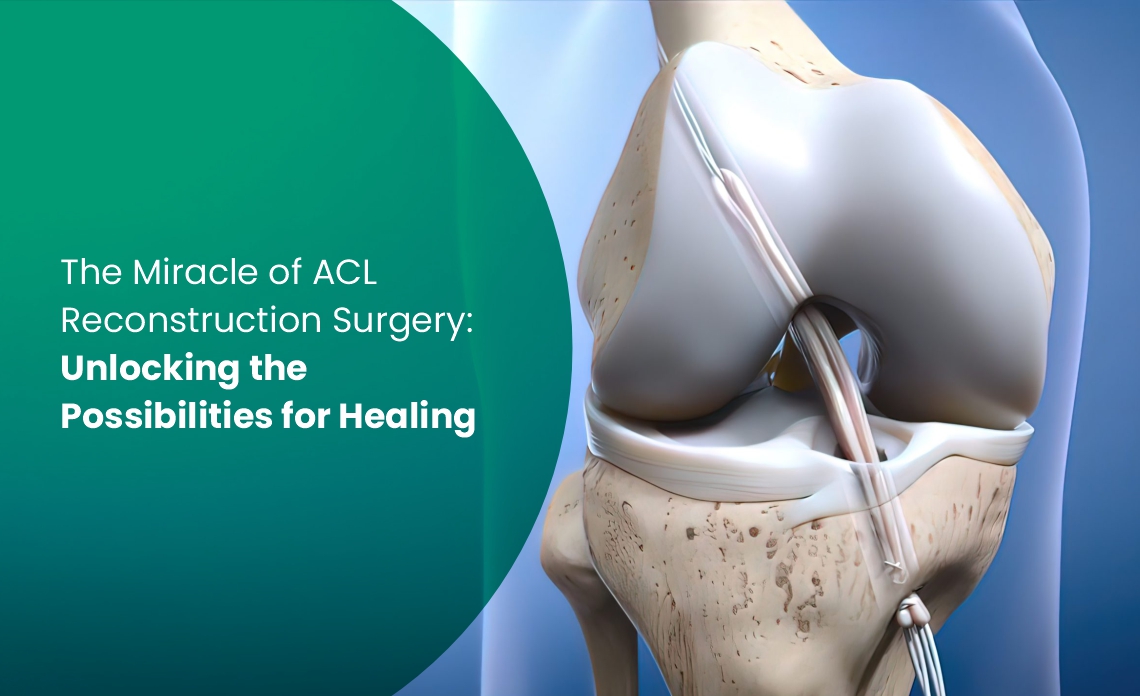
An important ligament in the knee that aids in stabilizing the joint is the Anterior Cruciate Ligament (ACL). It is in charge of limiting how far the shinbone may advance in respect to the thigh bone. ACL tears occur often, particularly in athletes who compete in sports that require turning, cutting, and leaping.
A procedure called ACL reconstruction surgery is used to repair an ACL that has torn. During surgery, a graft is used to replace the damaged ligament. This graft may be an autograft or an allograft derived from a cadaver.
What Does the ACL Reconstruction Process include?
The ACL reconstruction process involves several steps, including:
» Preoperative planning: Before surgery, doctors discuss the procedure, answer questions, perform a physical exam, and order tests like MRI to assess injury extent.
» Surgery: The surgery is typically arthroscopic, involving small incisions in the knee and a camera for guidance. A torn ligament is removed, and a graft is inserted, either from the patient’s body or a cadaver.
» Postoperative care: After surgery, you will be placed in a brace and will need to use crutches. You will also need to start physical therapy to help you regain range of motion and strength in your knee.
» Recovery: The recovery time after ACL reconstruction surgery varies from person to person. However, most people can return to their previous level of activity within 6 to 12 months.
Assessing ACL surgery requires considering injury severity, physical activity, and personal goals. Medical professionals can evaluate the condition, but common indications suggest surgery is necessary.
Symptoms
An ACL (Anterior Cruciate Ligament) injury often exhibits the following signs and symptoms:
- Popping Sensation
- Severe Pain
- Swelling
- Limited Range of Motion
- Instability
- Feeling of “Giving Out”
- Tenderness
- Bruising
- Difficulty Walking
Causes
ACL (Anterior Cruciate Ligament) injuries can have a variety of causes, but most frequently result from damage to the knee or rapid, violent movements. Common causes include:
- Sports Injuries
- Pivoting or Twisting Motions
- Direct Impact to the Knee
- Landing Incorrectly
- Non-contact Injuries
- Muscle Imbalances
- Previous ACL Injury
Risk factors
Risk factors for an ACL (Anterior Cruciate Ligament) injury include various factors that can increase the likelihood of experiencing such an injury. These risk factors can be categorised as follows:
- Sports Participation: Engaging in certain high-impact sports or activities that involve sudden stops, pivoting, or jumping increases the risk of ACL injury. Sports such as soccer, basketball, football, skiing, and tennis pose higher risks.
- Gender: Females have a higher risk of ACL injury compared to males. This is attributed to differences in anatomical, muscular, and hormonal differences.
- Age: Adolescents and young adults are at a higher risk of ACL injury, especially during growth spurts when coordination and muscle strength may not match the changes in bone length.
- Previous Injury: Individuals who have previously suffered an ACL injury are more susceptible to re-injury, as the ligament may not fully heal or regain its original strength.
- Muscle Imbalance: Weakness or imbalance between the quadriceps and hamstrings can place added stress on the ACL during movements, increasing the risk of injury.
- Improper Technique: Poor landing techniques, sudden deceleration, or incorrect pivoting during physical activities can put undue strain on the ACL.
- Footwear and Playing Surface: Inadequate footwear or playing on surfaces with poor traction can contribute to ACL injuries, as it affects stability and control during movements.
- Genetic Predisposition: Some individuals may have a genetic predisposition to ligamentous laxity, which can make their ACL more prone to injury.
- Non-contact Movements: ACL injuries can occur without direct contact with another person when making sudden, awkward movements or landing incorrectly from a jump.
- Level of Physical Activity: Athletes who participate at high levels of competition or engage in intense training sessions may have a higher risk due to increased exposure to potentially injurious movements.
Benefits of ACL Reconstruction Surgery
The benefits of ACL reconstruction surgery include:
- Improved stability: ACL reconstruction surgery can help to restore the stability of the knee joint. This can help to prevent further injuries and allow you to return to your normal activities.
- Reduced pain and swelling: ACL reconstruction surgery can help to reduce pain and swelling in the knee joint. This can make it easier to move around and participate in activities.
- Faster return to sport and activities: With proper rehabilitation, most people who undergo ACL reconstruction surgery can return to their pre-injury activities within 6 months to a year.
- Reduced risk of future knee injuries: ACL reconstruction surgery can help to reduce the risk of future knee injuries. This is because the reconstructed ACL is stronger and more resistant to injury than the original ACL.
- Preventing chronic knee problems: ACL reconstruction surgery can help to prevent the development of chronic knee problems, such as osteoarthritis.
It is important to note that ACL reconstruction surgery is a major surgery and there are some risks associated with it. However, the benefits of ACL reconstruction surgery can be significant, especially for active people who want to return to their normal activities.
Prevention
Preventing an ACL (Anterior Cruciate Ligament) injury involves a combination of strategies and practices to reduce the risk of injury during physical activities. Some effective prevention methods include:
- Proper Warm-up and Stretching
- Strength and Conditioning Training
- Balance and Proprioception Exercises
- Technique and Movement Training
- Sports-specific Training
- Use of Protective Equipment
- Avoiding Overtraining
- Maintaining a Healthy Weight
- Monitor Hormonal Changes in Female Athletes
With proper care and rehabilitation, most people who undergo ACL reconstruction surgery can return to their normal activities. For more information or inquiry, please call +91 98254 45403/09 or email: info@saraswatihospitals.com.

